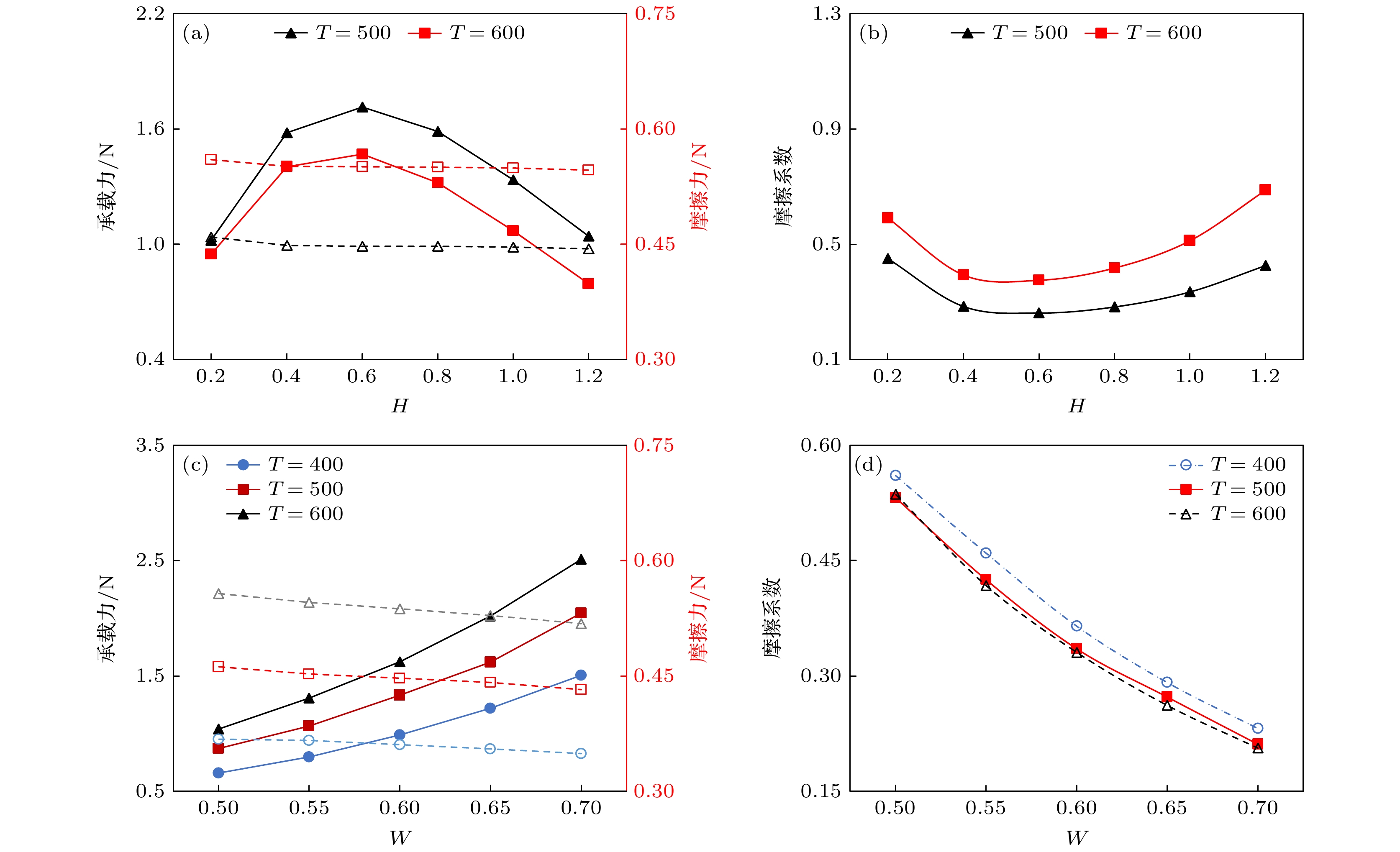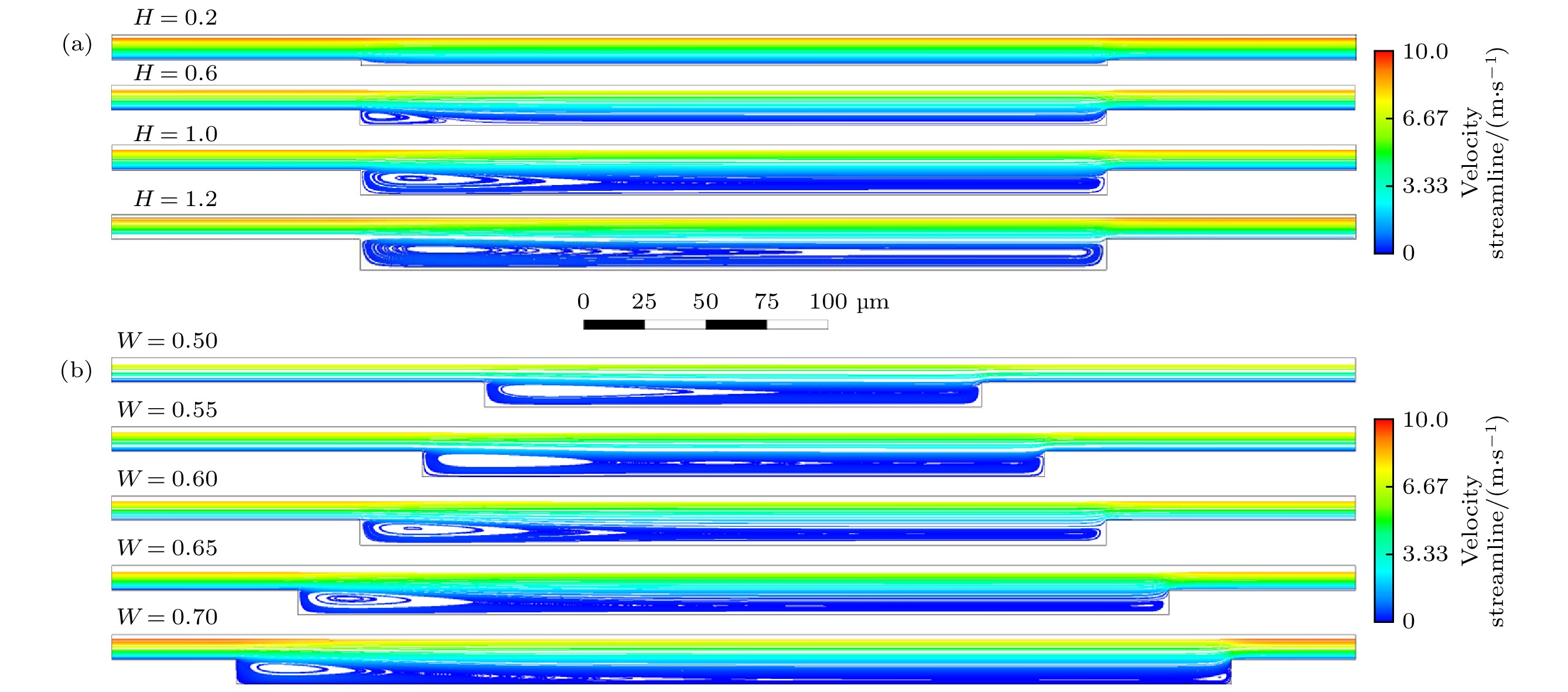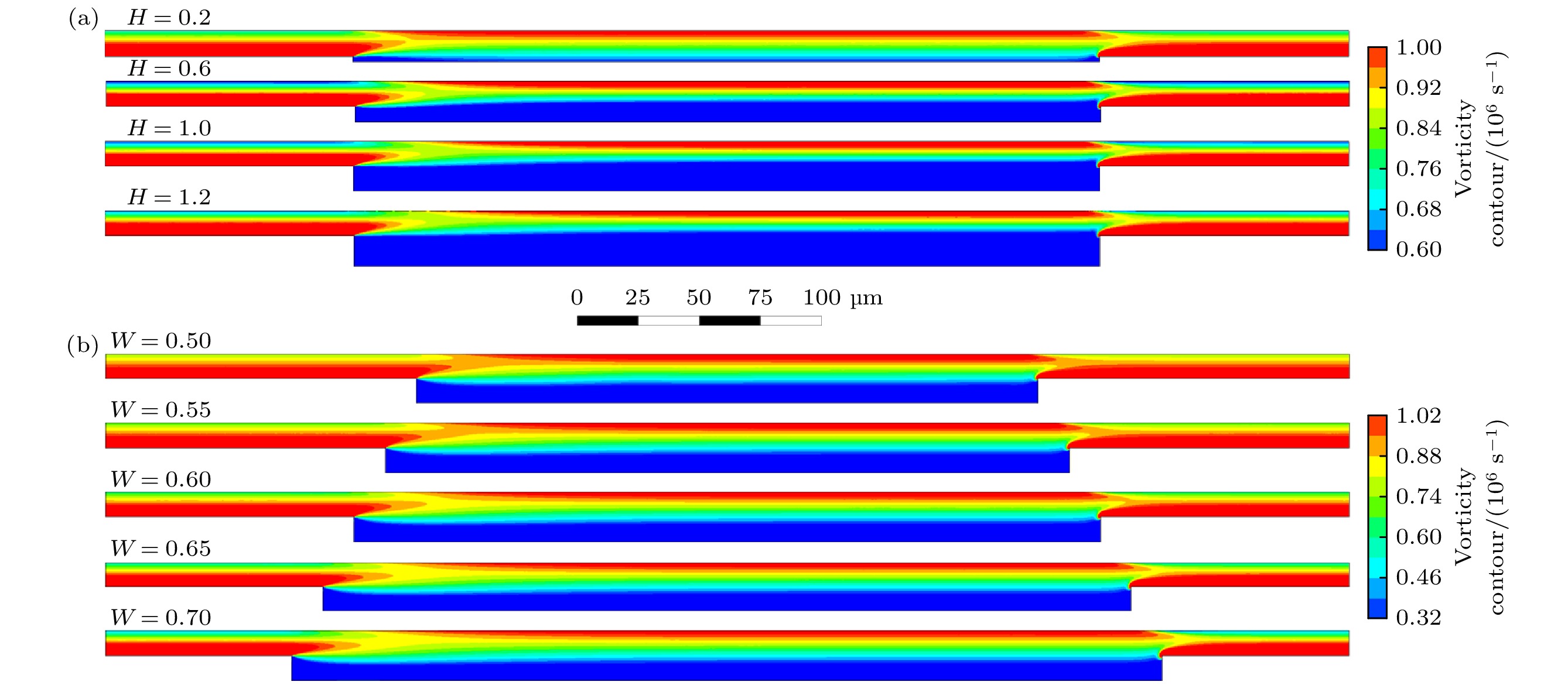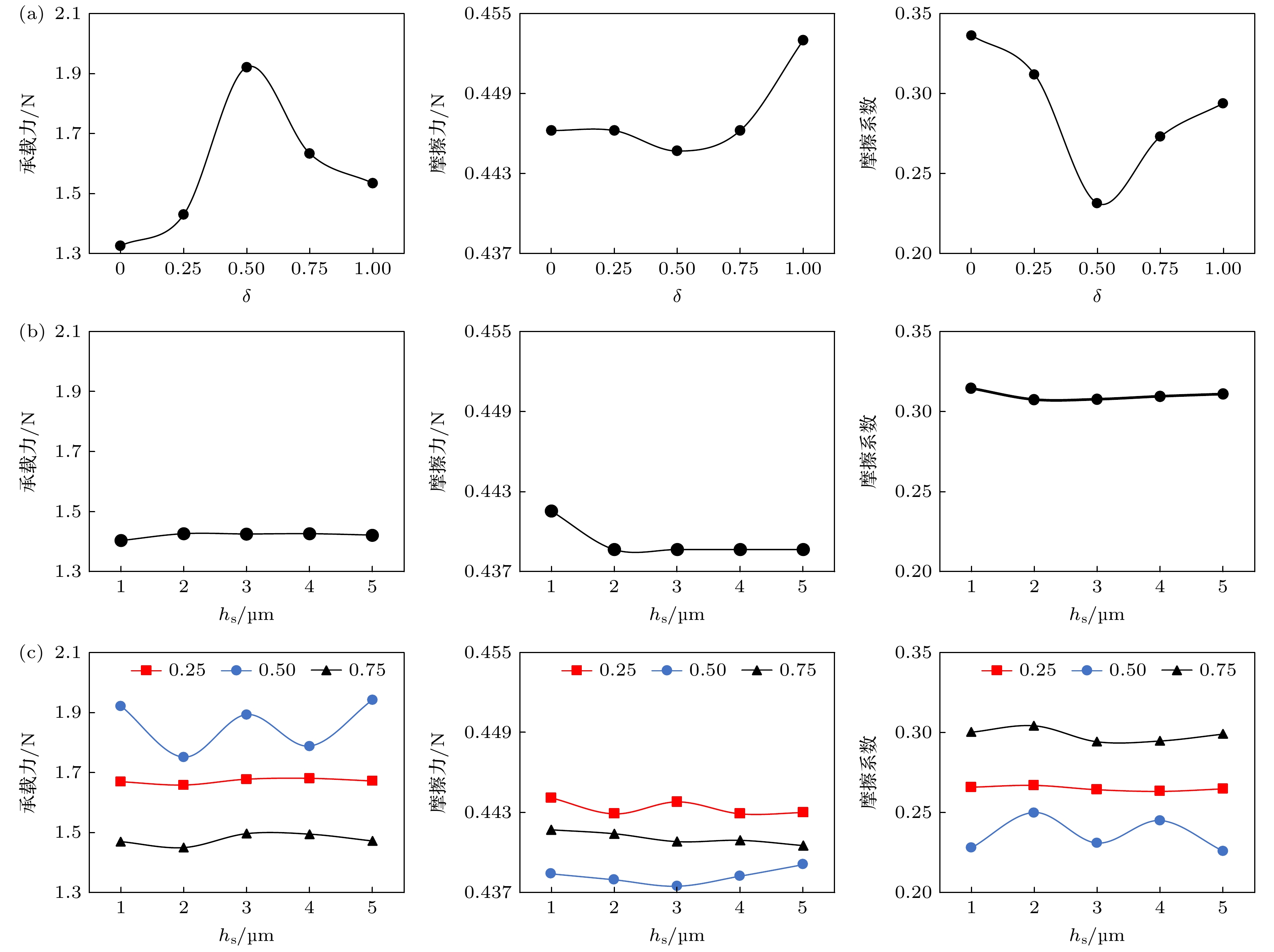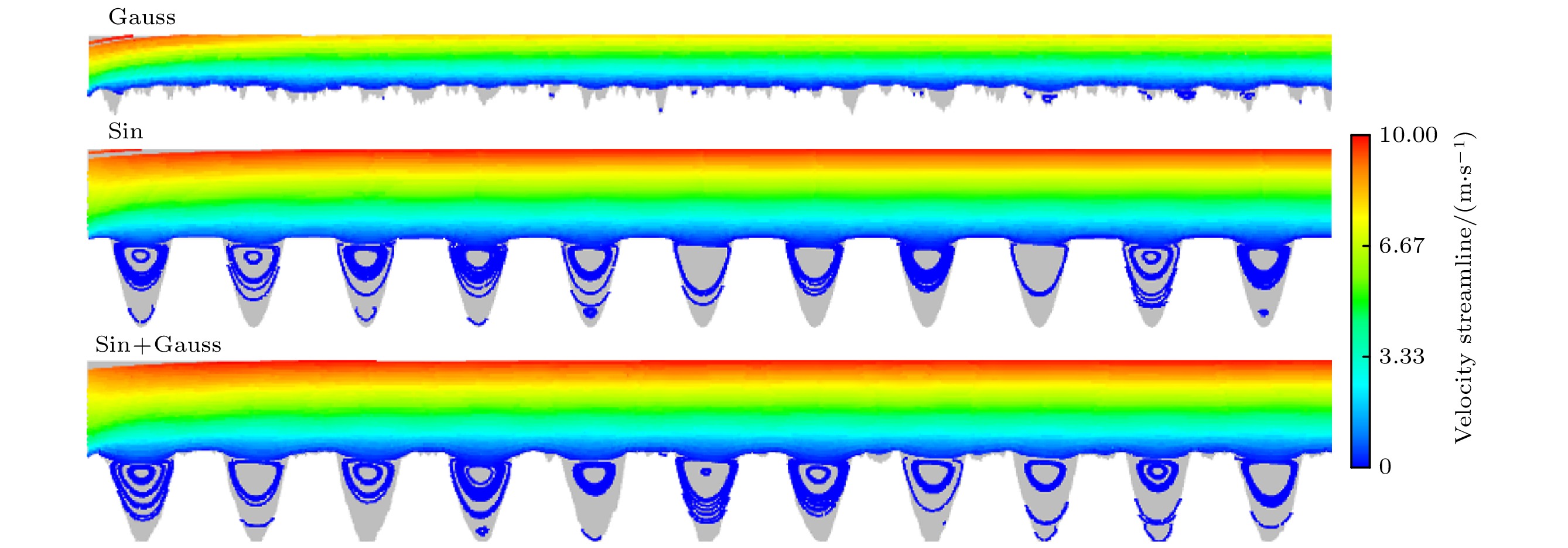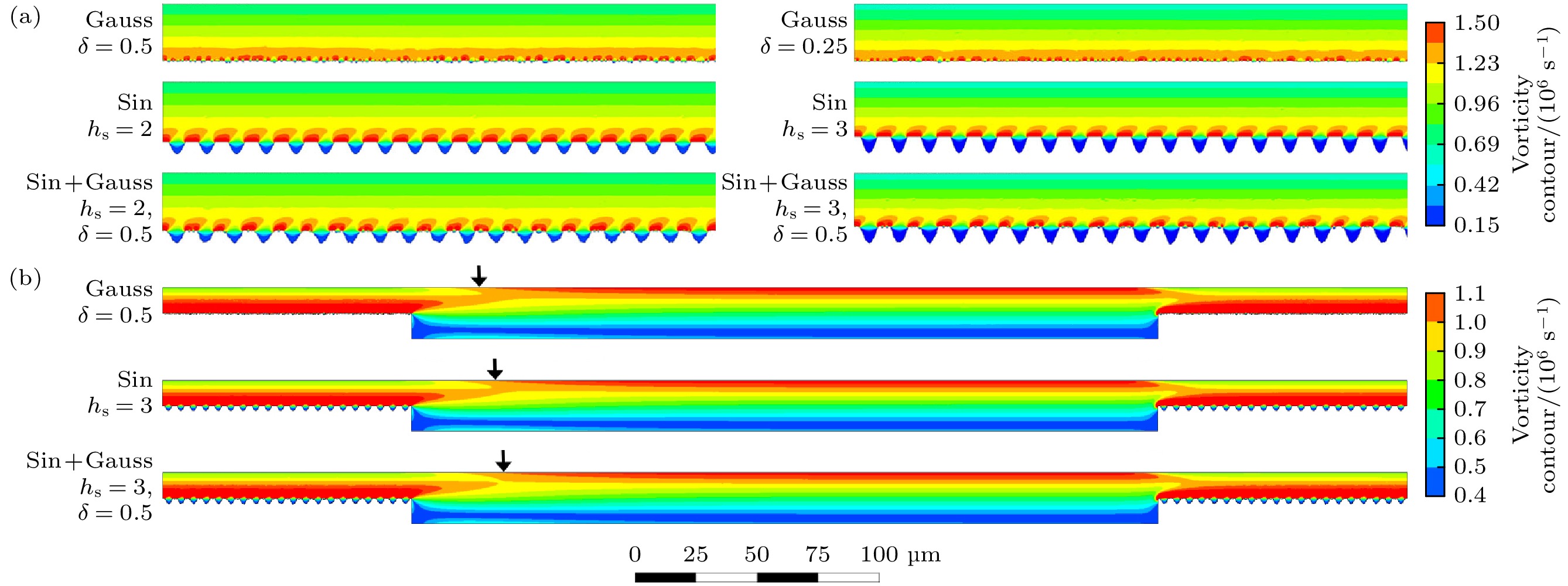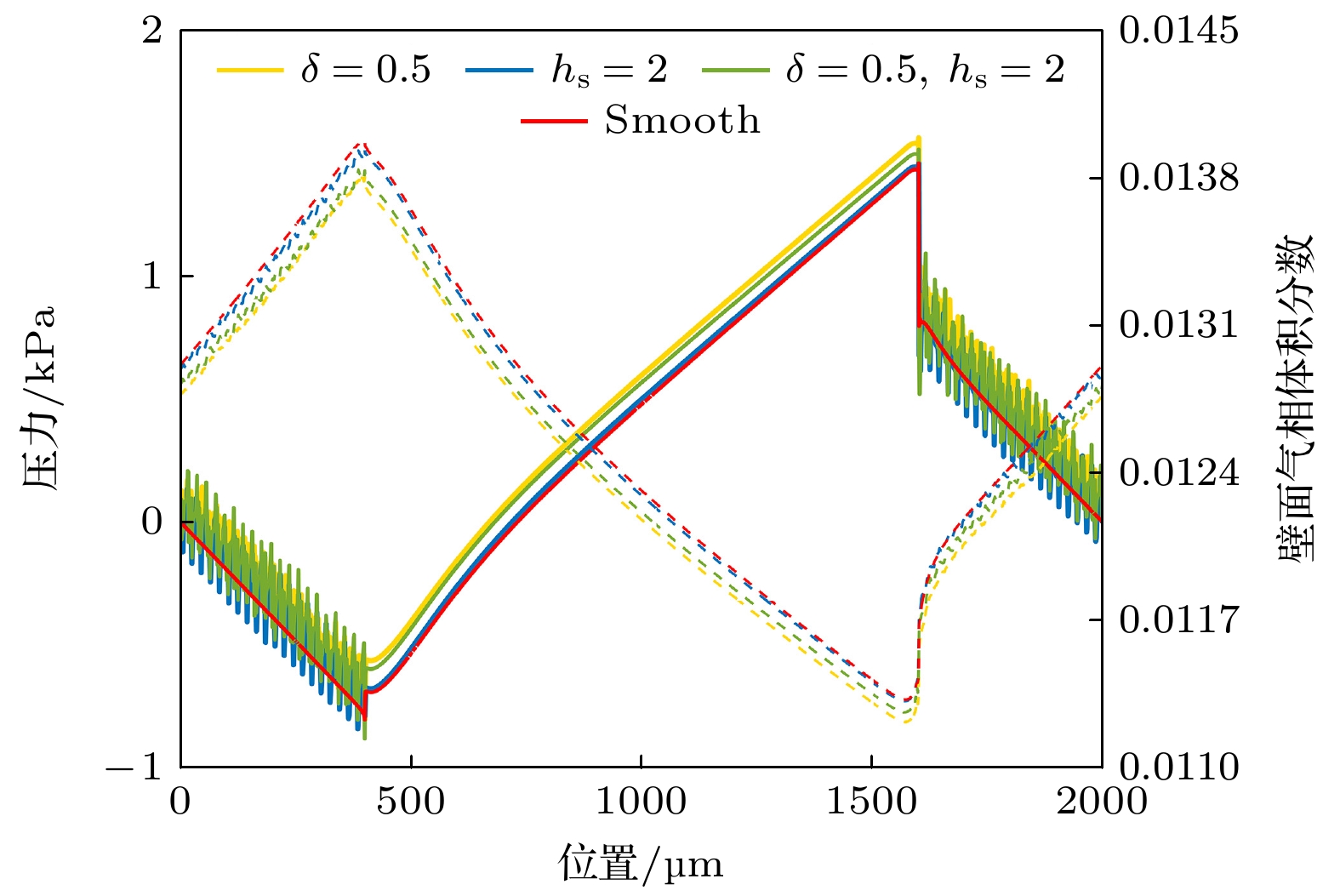-
With the development of surface precision machining technology and extensive studies on lubrication and friction reduction, the use of surface texture to reduce friction has attracted widespread attention, but few studies have considered the influence of surface roughness on lubrication characteristics. By employing the computational fluid dynamics (CFD) simulation method, the lubrication models with rectangular textures and the introduction of rough asperity structures at the same time are established. The effects of the corresponding structure parameters on the lubrication performance of textured and roughed surfaces are studied under water lubrication conditions. Our results suggest that the adjustment of geometric parameters on the micro-/nano-structured surfaces can influence the load-bearing capacity of the water lubrication film, thus affecting the hydrodynamic lubrication performance on the surface. In addition, the generation of vortex in the micro-textures can bring changes in vorticity, which causes energy dissipation and affects frictional forces. In the lubrication model with rectangular textures, optimal hydrodynamic lubrication performance is obtained under the appropriate depth ratio H = 0.6. Meanwhile, the corresponding lubrication performance can be enhanced by increasing the width ratio (W) of surface texture. After introducing random asperity structures on the micro-textured surface with a standard deviation δ = 0.5, the bearing capacity is increased by 44%, and the friction coefficient is reduced by 30.9%. Moreover, the introduction of half-sine rough asperity structures can only result in relatively minor differences in the lubrication performance, i.e. the changes of bearing capacity and friction coefficient are less than 10%. However, the introduction of compound hierarchical structure consisting of random asperity structures and half-sine rough asperity structures can result in an increase in the corresponding bearing capacity by 42% and a reduction in the friction coefficient by 31.1%, which implies a significant enhancement in the hydrodynamic lubrication performance.
-
Keywords:
- micro-texture /
- roughness /
- hydrodynamic lubrication /
- computational fluid dynamics simulation
[1] Hamilton D B, Walowit J A, Allen C M 1966 J. Fluids Eng. 88 177
[2] Zhong Y H, Zheng L, Gao Y H, Liu Z N 2019 Tribol. Int. 129 151
 Google Scholar
Google Scholar
[3] Mourier L, Mazuyer D, Ninove F P, Lubrecht A A 2010 Proc. Inst. Mech. Eng. , Part J: J. Eng. Tribol. 224 697.
 Google Scholar
Google Scholar
[4] Zhang J Y, Meng Y G 2012 Tribol. Lett. 46 147
 Google Scholar
Google Scholar
[5] Gropper D, Wang L, Harvey T J 2016 Tribol. Int. 94 509
 Google Scholar
Google Scholar
[6] Braun D, Greiner C, Schneider J, Gumbsch P 2014 Tribol. Int. 77 142
 Google Scholar
Google Scholar
[7] Hsu S M, Jing Y, Hua D, Zhang H 2014 J. Phys. D: Appl. Phys. 47 335307
 Google Scholar
Google Scholar
[8] 安书董, 王晓燕, 陈仙, 王炎武, 王晓波, 赵玉清 2015 物理学报 64 036801
 Google Scholar
Google Scholar
An S D, Wang X Y, Chen X, Wang Y W, Wang X B, Zhao Y Q 2015 Acta Phys. Sin. 64 036801
 Google Scholar
Google Scholar
[9] Rosenkranz A, Szurdak A, Gachot C, Hirt G, Mücklich F 2016 Tribol. Int. 95 290.
 Google Scholar
Google Scholar
[10] 纪敬虎, 管采薇, 符昊, 华希俊, 符永宏 2018 润滑与密封 43 20
 Google Scholar
Google Scholar
Ji J H, Guan C W, Fu H, Hua X J, Fu Y H 2018 Lubr. Eng. 43 20
 Google Scholar
Google Scholar
[11] Qiu Y, Khonsari M M 2011 J. Tribol. 133 021704
 Google Scholar
Google Scholar
[12] Lahayne O, Pichler B, Reihsner R, Eberhardsteiner J, Suh J, Kim D, Nam S, Paek H, Lorenz B, Persson B N J 2016 Tribol. Lett. 62 17
 Google Scholar
Google Scholar
[13] Feng D, Shen M X, Peng X D, Meng X K 2017 Tribol. Lett. 65 1
 Google Scholar
Google Scholar
[14] Sedlaček M, Podgornik B, Vižintin J 2009 Wear 266 482
 Google Scholar
Google Scholar
[15] Menezes P L, Kishore, Kailas S V, Lovell M R 2011 Tribol. Lett. 41 1
 Google Scholar
Google Scholar
[16] Rasp W, Wichern C M 2002 J. Mater. Process. Technol. 125 379
[17] 王悦昶, 刘莹, 黄伟峰, 郭飞, 王玉明 2016 摩擦学学报 36 520
Wang Y C, Liu Y, Huang W F, Guo F, Wang Y M 2016 Tribology 36 520
[18] Rosenkranz A, Costa H L, Profito F, Gachot C, Medina S, Dini D 2019 Tribol. Int. 134 190
 Google Scholar
Google Scholar
[19] Brajdic-Mitidieri P, Gosman A D, Ioannides E, Spikes H A 2005 J. Tribol. 127 803
 Google Scholar
Google Scholar
[20] Sahlin F, Glavatskih S B, Almqvist T, Larsson R 2005 J. Tribol. 127 96
 Google Scholar
Google Scholar
[21] Vilhena L, Sedlaček M, Podgornik B, Rek Z, Žun I 2018 Lubricants 6 15
 Google Scholar
Google Scholar
[22] Zhang L, Luo J, Yuan R B, He M 2012 Procedia Eng. 31 220
 Google Scholar
Google Scholar
[23] 禄晓敏, 王权岱, 肖继明, 杨振朝 2016 润滑与密封 41 70
 Google Scholar
Google Scholar
Lu X M, Wang Q D, Xiao J M, Yang Z C 2016 Lubr. Eng. 41 70
 Google Scholar
Google Scholar
[24] Mao Y, Zeng L C, Lu Y 2016 Tribol. Int. 104 212
 Google Scholar
Google Scholar
[25] Ma X 2023 Lubricants 11 270
 Google Scholar
Google Scholar
[26] Li Q, Zhang S, Wang Y J, Xu W W, Wang Z B 2019 Ind. Lubr. Tribol. 71 109
 Google Scholar
Google Scholar
[27] He T, Li J M, Deng H S, Wang C L, Shi R, Chen G Y, Li Z P 2021 AIP Adv. 11 015222
 Google Scholar
Google Scholar
[28] Singhal A K, Athavale M M, Li H, Jiang Y 2002 ASME J. Fluids Eng. 124 617
 Google Scholar
Google Scholar
[29] Pellone C, Franc J P, Perrin M 2004 C. R. Math. 332 827
[30] Buscaglia G C, El Alaoui Talibi M, Jai M 2015 Math. Comput. Simul 118 130
 Google Scholar
Google Scholar
[31] Wei Y, Tomkowski R, Archenti A 2020 Metals 10 361
 Google Scholar
Google Scholar
[32] Wang W, He Y Y, Li Y, Wei B, Hu Y T, Luo J B 2018 Ind. Lubr. Tribol. 70 754
 Google Scholar
Google Scholar
[33] Gao G Y, Yin Z W, Jiang D, Zhang X L 2014 Tribol. Int. 75 31
 Google Scholar
Google Scholar
[34] Podgornik B, Vilhena L M, Sedlaček M, Rek Z, Žun I 2012 Meccanica 47 1613
 Google Scholar
Google Scholar
[35] Shankar P N, Deshpande M D 2000 Annu. Rev. Fluid Mech. 32 93
 Google Scholar
Google Scholar
[36] Sahlin F, Almqvist A, Larsson R, Glavatskih S 2007 Tribol. Int. 40 1294
 Google Scholar
Google Scholar
[37] Ausas R, Ragot P, Leiva J, Jai M, Bayada G, Buscaglia G C 2007 J. Tribol. 129 868
 Google Scholar
Google Scholar
[38] Wahl R, Schneider J, Gumbsch P 2012 Tribol. Int. 55 81.
 Google Scholar
Google Scholar
[39] 刘天霞, 李靖, 卢星, 江志波 2023 润滑与密封 48 74
 Google Scholar
Google Scholar
Liu T X, Li J, Lu X, Jiang Z B 2023 Lubr. Eng. 48 74
 Google Scholar
Google Scholar
[40] Babu P V, Ismail S, Ben B S 2021 Proc. Inst. Mech. Eng. , Part J: J. Eng. Tribol. 235 360
 Google Scholar
Google Scholar
[41] Wos S, Koszela W, Pawlus P 2020 Tribol. Int. 146 106205.
 Google Scholar
Google Scholar
[42] Wang J H, Yan Z J, Fang X, Shen Z Y, Pan X X 2020 Lubr. Sci. 32 404
 Google Scholar
Google Scholar
[43] Venkateswara Babu P, Syed I, Benbeera S 2020 Mater. Today Proc. 24 1112
 Google Scholar
Google Scholar
[44] 樊智敏, 马瑞磷, 江峰 2021 润滑与密封 46 44
 Google Scholar
Google Scholar
Fan Z M, Ma R L, Jiang F 2021 Lubr. Eng. 46 44
 Google Scholar
Google Scholar
[45] 纪敬虎, 周加鹏, 王沫阳, 王伟, 符永宏 2019 表面技术 48 139
Ji J H, Zhou J P, Wang M Y, Wang W, Fu Y H 2019 Surf. Technol. 48 139
[46] Jiang Y Y, Yan Z J, Zhang S W, Shen Z Y, Sun H C 2022 Sci. Rep. 12 13455
 Google Scholar
Google Scholar
[47] Wang Y, Jacobs G, König F, Zhang S, von Goeldel S 2023 Lubricants 11 20
 Google Scholar
Google Scholar
[48] Huang J Y, Guan Y C, Ramakrishna S 2021 Tribol. Int. 162 107115
 Google Scholar
Google Scholar
-
图 2 润滑模型Ⅰ和Ⅱ的润滑特性 (a) 模型Ⅰ的承载力与摩擦力; (b) 模型Ⅰ的摩擦系数; (c) 模型Ⅱ的承载力与摩擦力; (d) 模型Ⅱ的摩擦系数
Figure 2. The lubrication performance in models I and II: (a) Bearing capacity and friction force in model I; (b) frictional coefficient in model I; (c) bearing capacity and friction force in model II; (d) frictional coefficient in model II.
图 6 计入不同粗糙峰结构的润滑模型的润滑特性 (a) Gauss模型中承载力、摩擦力与摩擦系数; (b) Sin模型中承载力、摩擦力与摩擦系数; (c) Sin+Gauss模型中承载力、摩擦力与摩擦系数
Figure 6. The lubrication performance on the textured models with rough peaks: (a) The bearing capacity, frictional force and frictional coefficient in the Gauss model; (b) the bearing capacity, frictional force and frictional coefficient in the Sin model; (c) the bearing capacity, frictional force and frictional coefficient in the Sin+Gauss model.
表 1 水润滑微织构模型参数变化
Table 1. The geometrical parameters for textured models.
模型 T0 W H 模型Ⅰ (恒定宽度比W ) 500/600 0.60 0.2/ 0.4/ 0.6/ 0.8 /1.0/ 1.2 模型Ⅱ (恒定深度比H ) 400/500/600 0.50/ 0.55/ 0.60 /0.65/ 0.70 1.0 表 2 润滑模型中的下壁面微观形貌示意图
Table 2. Sketch maps of textures on the lower wall surfaces of the lubrication models.
模型名称 微织构表面粗糙峰轮廓 函数变化参数 光滑表面
(Smooth)
δ = 0
hs = 0Gauss 
δ = 0.25/0.5/0.75/1
hs = 0Sin 
δ = 0
hs = 1/2/3/4/5
l = 3
i = 1Sin+Gauss 
δ = 0.25/0.5/0.75/1
hs = 1/2/3/4/5
l = 3
i = 3 -
[1] Hamilton D B, Walowit J A, Allen C M 1966 J. Fluids Eng. 88 177
[2] Zhong Y H, Zheng L, Gao Y H, Liu Z N 2019 Tribol. Int. 129 151
 Google Scholar
Google Scholar
[3] Mourier L, Mazuyer D, Ninove F P, Lubrecht A A 2010 Proc. Inst. Mech. Eng. , Part J: J. Eng. Tribol. 224 697.
 Google Scholar
Google Scholar
[4] Zhang J Y, Meng Y G 2012 Tribol. Lett. 46 147
 Google Scholar
Google Scholar
[5] Gropper D, Wang L, Harvey T J 2016 Tribol. Int. 94 509
 Google Scholar
Google Scholar
[6] Braun D, Greiner C, Schneider J, Gumbsch P 2014 Tribol. Int. 77 142
 Google Scholar
Google Scholar
[7] Hsu S M, Jing Y, Hua D, Zhang H 2014 J. Phys. D: Appl. Phys. 47 335307
 Google Scholar
Google Scholar
[8] 安书董, 王晓燕, 陈仙, 王炎武, 王晓波, 赵玉清 2015 物理学报 64 036801
 Google Scholar
Google Scholar
An S D, Wang X Y, Chen X, Wang Y W, Wang X B, Zhao Y Q 2015 Acta Phys. Sin. 64 036801
 Google Scholar
Google Scholar
[9] Rosenkranz A, Szurdak A, Gachot C, Hirt G, Mücklich F 2016 Tribol. Int. 95 290.
 Google Scholar
Google Scholar
[10] 纪敬虎, 管采薇, 符昊, 华希俊, 符永宏 2018 润滑与密封 43 20
 Google Scholar
Google Scholar
Ji J H, Guan C W, Fu H, Hua X J, Fu Y H 2018 Lubr. Eng. 43 20
 Google Scholar
Google Scholar
[11] Qiu Y, Khonsari M M 2011 J. Tribol. 133 021704
 Google Scholar
Google Scholar
[12] Lahayne O, Pichler B, Reihsner R, Eberhardsteiner J, Suh J, Kim D, Nam S, Paek H, Lorenz B, Persson B N J 2016 Tribol. Lett. 62 17
 Google Scholar
Google Scholar
[13] Feng D, Shen M X, Peng X D, Meng X K 2017 Tribol. Lett. 65 1
 Google Scholar
Google Scholar
[14] Sedlaček M, Podgornik B, Vižintin J 2009 Wear 266 482
 Google Scholar
Google Scholar
[15] Menezes P L, Kishore, Kailas S V, Lovell M R 2011 Tribol. Lett. 41 1
 Google Scholar
Google Scholar
[16] Rasp W, Wichern C M 2002 J. Mater. Process. Technol. 125 379
[17] 王悦昶, 刘莹, 黄伟峰, 郭飞, 王玉明 2016 摩擦学学报 36 520
Wang Y C, Liu Y, Huang W F, Guo F, Wang Y M 2016 Tribology 36 520
[18] Rosenkranz A, Costa H L, Profito F, Gachot C, Medina S, Dini D 2019 Tribol. Int. 134 190
 Google Scholar
Google Scholar
[19] Brajdic-Mitidieri P, Gosman A D, Ioannides E, Spikes H A 2005 J. Tribol. 127 803
 Google Scholar
Google Scholar
[20] Sahlin F, Glavatskih S B, Almqvist T, Larsson R 2005 J. Tribol. 127 96
 Google Scholar
Google Scholar
[21] Vilhena L, Sedlaček M, Podgornik B, Rek Z, Žun I 2018 Lubricants 6 15
 Google Scholar
Google Scholar
[22] Zhang L, Luo J, Yuan R B, He M 2012 Procedia Eng. 31 220
 Google Scholar
Google Scholar
[23] 禄晓敏, 王权岱, 肖继明, 杨振朝 2016 润滑与密封 41 70
 Google Scholar
Google Scholar
Lu X M, Wang Q D, Xiao J M, Yang Z C 2016 Lubr. Eng. 41 70
 Google Scholar
Google Scholar
[24] Mao Y, Zeng L C, Lu Y 2016 Tribol. Int. 104 212
 Google Scholar
Google Scholar
[25] Ma X 2023 Lubricants 11 270
 Google Scholar
Google Scholar
[26] Li Q, Zhang S, Wang Y J, Xu W W, Wang Z B 2019 Ind. Lubr. Tribol. 71 109
 Google Scholar
Google Scholar
[27] He T, Li J M, Deng H S, Wang C L, Shi R, Chen G Y, Li Z P 2021 AIP Adv. 11 015222
 Google Scholar
Google Scholar
[28] Singhal A K, Athavale M M, Li H, Jiang Y 2002 ASME J. Fluids Eng. 124 617
 Google Scholar
Google Scholar
[29] Pellone C, Franc J P, Perrin M 2004 C. R. Math. 332 827
[30] Buscaglia G C, El Alaoui Talibi M, Jai M 2015 Math. Comput. Simul 118 130
 Google Scholar
Google Scholar
[31] Wei Y, Tomkowski R, Archenti A 2020 Metals 10 361
 Google Scholar
Google Scholar
[32] Wang W, He Y Y, Li Y, Wei B, Hu Y T, Luo J B 2018 Ind. Lubr. Tribol. 70 754
 Google Scholar
Google Scholar
[33] Gao G Y, Yin Z W, Jiang D, Zhang X L 2014 Tribol. Int. 75 31
 Google Scholar
Google Scholar
[34] Podgornik B, Vilhena L M, Sedlaček M, Rek Z, Žun I 2012 Meccanica 47 1613
 Google Scholar
Google Scholar
[35] Shankar P N, Deshpande M D 2000 Annu. Rev. Fluid Mech. 32 93
 Google Scholar
Google Scholar
[36] Sahlin F, Almqvist A, Larsson R, Glavatskih S 2007 Tribol. Int. 40 1294
 Google Scholar
Google Scholar
[37] Ausas R, Ragot P, Leiva J, Jai M, Bayada G, Buscaglia G C 2007 J. Tribol. 129 868
 Google Scholar
Google Scholar
[38] Wahl R, Schneider J, Gumbsch P 2012 Tribol. Int. 55 81.
 Google Scholar
Google Scholar
[39] 刘天霞, 李靖, 卢星, 江志波 2023 润滑与密封 48 74
 Google Scholar
Google Scholar
Liu T X, Li J, Lu X, Jiang Z B 2023 Lubr. Eng. 48 74
 Google Scholar
Google Scholar
[40] Babu P V, Ismail S, Ben B S 2021 Proc. Inst. Mech. Eng. , Part J: J. Eng. Tribol. 235 360
 Google Scholar
Google Scholar
[41] Wos S, Koszela W, Pawlus P 2020 Tribol. Int. 146 106205.
 Google Scholar
Google Scholar
[42] Wang J H, Yan Z J, Fang X, Shen Z Y, Pan X X 2020 Lubr. Sci. 32 404
 Google Scholar
Google Scholar
[43] Venkateswara Babu P, Syed I, Benbeera S 2020 Mater. Today Proc. 24 1112
 Google Scholar
Google Scholar
[44] 樊智敏, 马瑞磷, 江峰 2021 润滑与密封 46 44
 Google Scholar
Google Scholar
Fan Z M, Ma R L, Jiang F 2021 Lubr. Eng. 46 44
 Google Scholar
Google Scholar
[45] 纪敬虎, 周加鹏, 王沫阳, 王伟, 符永宏 2019 表面技术 48 139
Ji J H, Zhou J P, Wang M Y, Wang W, Fu Y H 2019 Surf. Technol. 48 139
[46] Jiang Y Y, Yan Z J, Zhang S W, Shen Z Y, Sun H C 2022 Sci. Rep. 12 13455
 Google Scholar
Google Scholar
[47] Wang Y, Jacobs G, König F, Zhang S, von Goeldel S 2023 Lubricants 11 20
 Google Scholar
Google Scholar
[48] Huang J Y, Guan Y C, Ramakrishna S 2021 Tribol. Int. 162 107115
 Google Scholar
Google Scholar
Catalog
Metrics
- Abstract views: 4592
- PDF Downloads: 114
- Cited By: 0














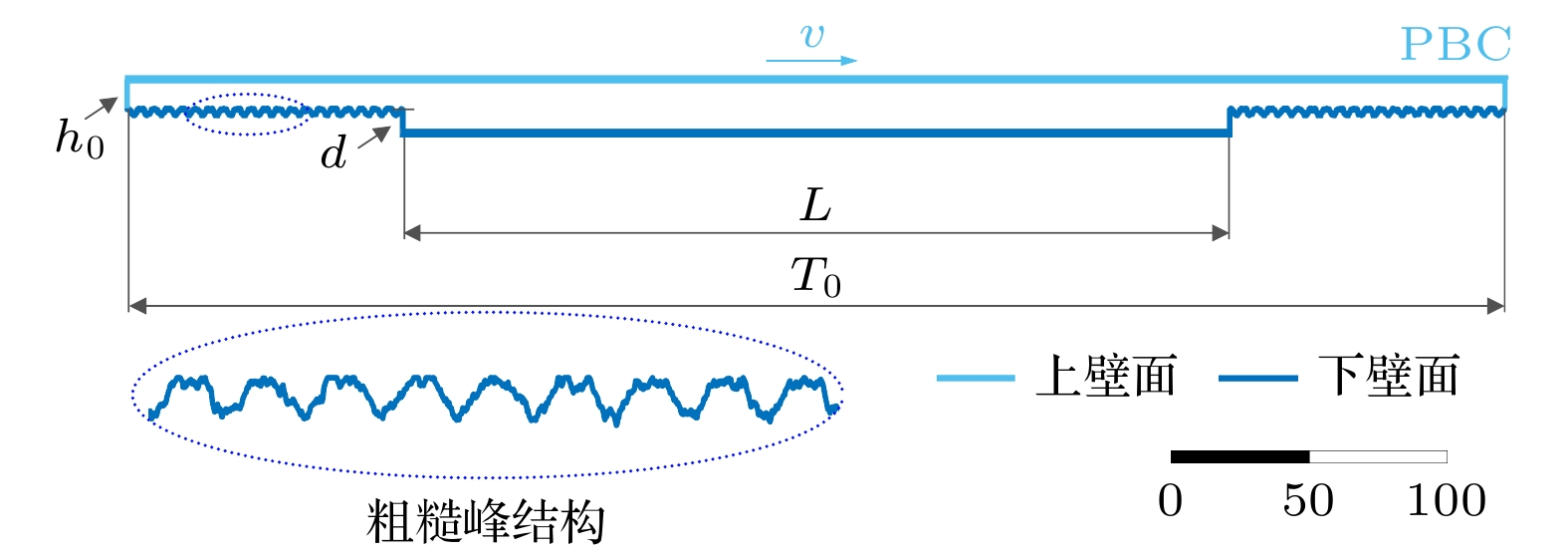
 DownLoad:
DownLoad:
